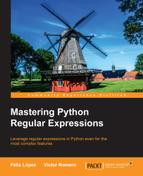As we've mentioned previously, one of the most powerful functionalities that grouping gives us is the possibility of using the captured group inside the regex or other operations. That's exactly what backreferences provide. Probably the best known example to bring some clarity is the regex to find duplicated words, as shown in the following code:
>>>pattern = re.compile(r"(w+) 1")
>>>match = pattern.search(r"hello hello world")
>>>match.groups()
('hello',)Here, we're capturing a group made up of one or more alphanumeric characters, after which the pattern tries to match a whitespace, and finally we have the 1 backreference. You can see it highlighted in the code, meaning that it must exactly match the same thing it matched as the first group.
Backreferences can be used with the first 99 groups .Obviously, with an increase in the number of groups, you will find the task of reading and maintaining the regex more complex. This is something that can be reduced with named groups; we'll see them in the following section. But before that, we still have a lot of things to learn with backreferences. So, let's continue with another operation in which backreferences really come in handy. Recall the previous example, in which we had a list of products. Now, let's try to change the order of the ID, so we have the ID in the DB, a dash, and the country code:
>>>pattern = re.compile(r"(d+)-(w+)")
>>>pattern.sub(r"2-1", "1-a
20-baer
34-afcr")
'a-1
baer-20
afcr-34'That's it. Easy, isn't it? Note that we're also capturing the ID in the DB, so we can use it later. With the highlighted code, we're saying, "Replace what you've matched with the second group, a dash, and the first group".
As with the previous example, using numbers can be difficult to follow and to maintain. So, let's see what Python, through the re module, offers to help with this.
